Engineering time is the most important and scarce resource in any software firm. Without a disciplined strategy for managing this resource, teams frequently become reactive, continually battling fires rather than making substantial progress toward corporate objectives.
Research shows that teams with formal allocation models deliver features faster than those operating without clear time distribution frameworks. This improvement comes from better planning, reduced context switching, and more predictable delivery schedules.
This article will guide you through building and implementing an investment allocation model that transforms how your engineering team approaches project planning and execution.
Understanding Investment Allocation in Software Projects
Investment allocation in software development is deliberately spreading engineering hours across various types of work to ensure both short-term delivery and long-term durability. Unlike financial budgeting, which focuses on monetary resources, time allocation is concerned with the human capital that creates your product.
The main distinction between time allocation and typical budgeting is in the resource itself:
- Time is non-renewable: Once spent, engineering hours cannot be recovered or redistributed.
- Skills vary significantly: Not all engineering hours are equivalent in value or capability.
- Context switching is costly: Frequent task switching reduces overall productivity.
- Technical debt accumulates: Poor allocation decisions compound over time.
A time allocation approach can be divided into four categories:
- Innovation (new features and R&D)
- Customer retention and support (bug fixes and user issues)
- Technical investments (infrastructure and architectural enhancements)
- KTLO (keep-the-lights-on maintenance work).
Core Components of an Effective Allocation Model
A robust allocation model requires an understanding of each work category’s unique characteristics and its corresponding business impact.
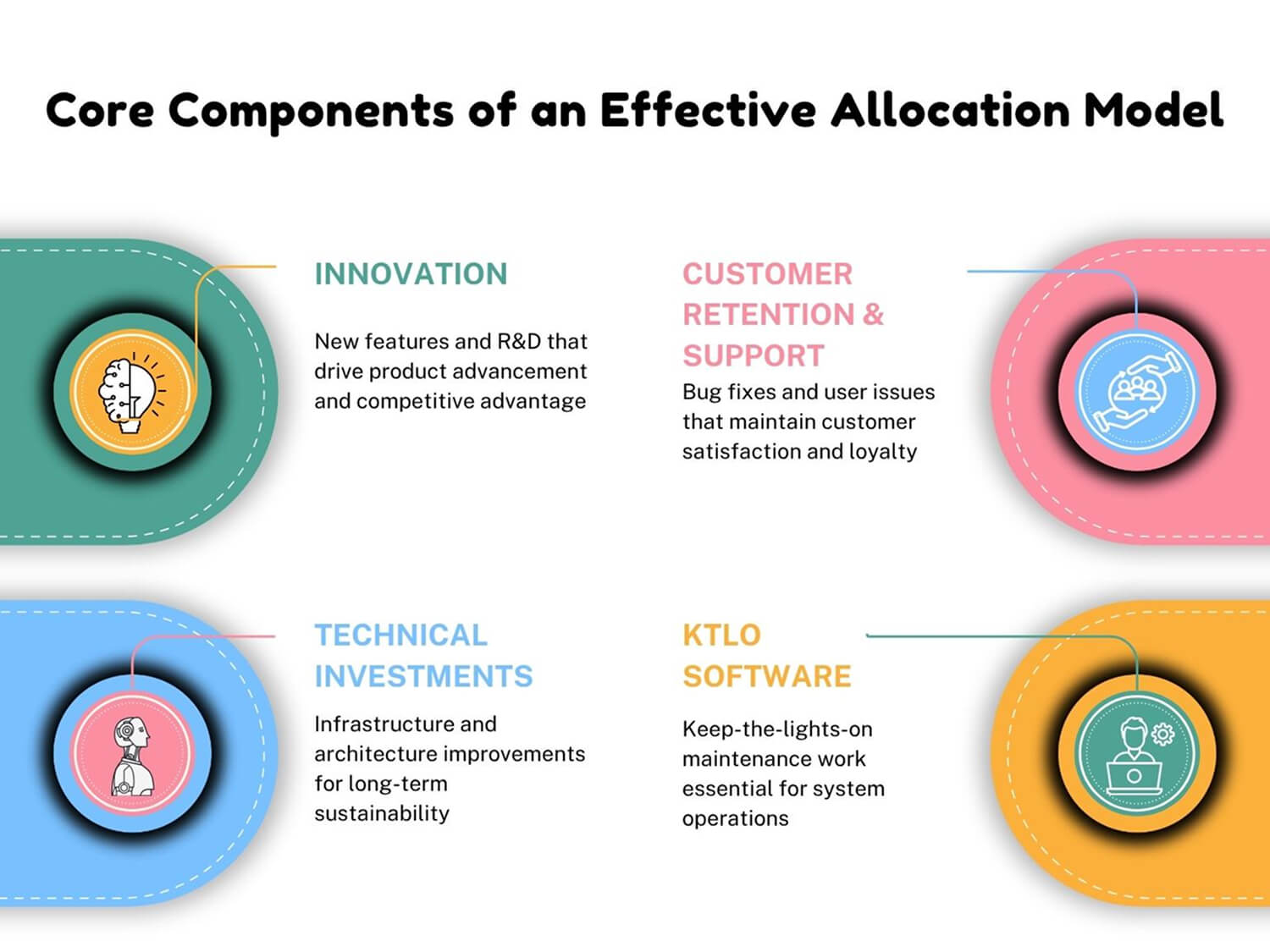
1. Innovation
Innovation work means building new features, exploring ideas through research, and testing small prototypes to make your product more competitive.
- New feature creation: Core product enhancements include expanding capabilities or improving user experience.
- Research and development: Exploratory work on emerging technologies or novel problem-solving approaches.
- Prototyping and proof-of-concepts: Small-scale tests to confirm technical feasibility or measure the market’s demand.
- Competitive differentiation projects: Features or capabilities designed to make your product distinct from alternatives.
2. Customer Retention & Support
Support activities center on maintaining and enhancing experiences for current users, directly affecting satisfaction and loyalty rates.
- Critical bug fixes: Fixing problems that block users from completing important tasks.
- User-reported problems: Handling concerns and problems submitted through support systems.
- Performance optimizations: Boosting speed and system dependability for enhanced user satisfaction.
- Documentation updates: Keeping technical and customer-facing materials current and accurate.
3. Technical Investments
Technical investment efforts strengthen your software’s core structure, boosting long-term sustainability and development pace while decreasing future technical debt.
- Code refactoring: Improving code structure and readability without changing external behavior.
- Architecture upgrades: Updating system structure to scale and new requirements.
- Infrastructure improvements: Strengthening deployment, monitoring, and development resources.
4. KTLO Software
Keep-the-lights-on (KTLO) software activities involve regular operational duties required to sustain system operations and organizational standards.
- System monitoring and alerting: Maintaining adequate insight into system wellness and performance.
- Security patches and updates: Installing vendor-supplied fixes and keeping software versions current.
- Backup and disaster recovery: Preserving data security and system restoration abilities.
KTLO software work is essential, but it should be minimized through automation and process improvements to free capacity for higher-value activities.
Building Your Time Allocation Template
Developing a successful time allocation model needs careful preparation and stakeholder alignment.
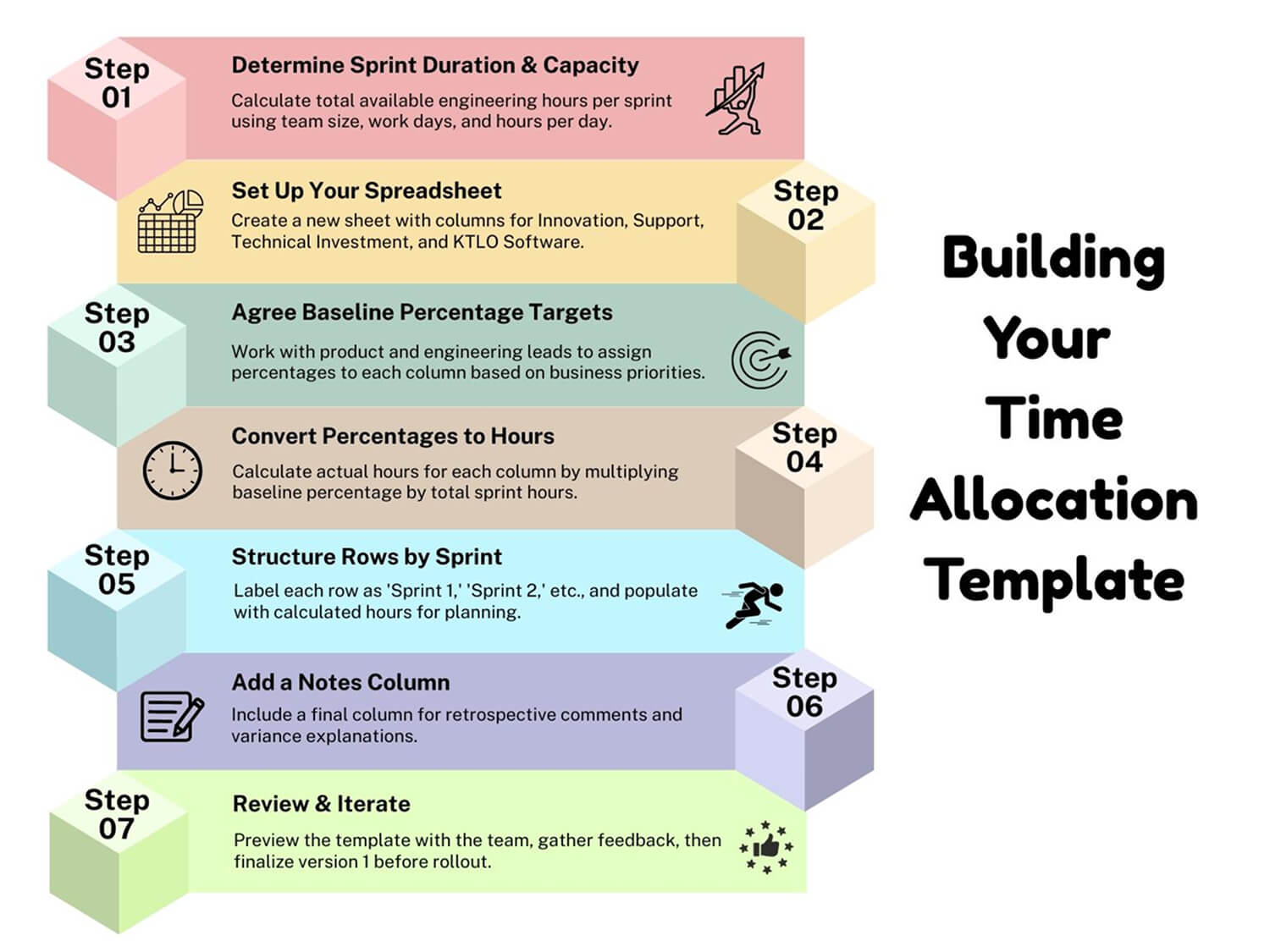
1. Determine Sprint Duration & Capacity
Start by calculating your team’s total available engineering hours per sprint.
- Count active team members: Count only developers who will be coding or directly participating in technical work.
- Account for standard work schedules: Use realistic estimates (7.5 hours/day is often more accurate than 8, due to meetings and breaks).
- Include known time off: Remove planned vacation, scheduled holidays, training, or other obligations.
- Calculate total capacity: Total available engineering hours per sprint can be calculated by the equation below.
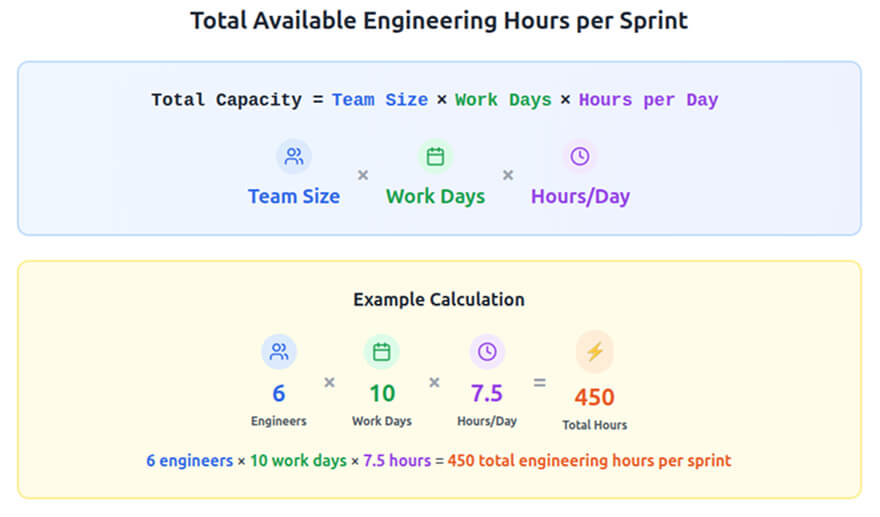
2. Set Up Your Spreadsheet
Create a structured spreadsheet that organizes your allocation categories and makes tracking straightforward.
- Column headers: Innovation, Support (Customer Retention & Bug Fixes), Technical Investment, KTLO Software
- Row structure: One row per sprint with clear sprint numbering or date ranges
- Formula cells: Automatic calculations for converting percentages to hours
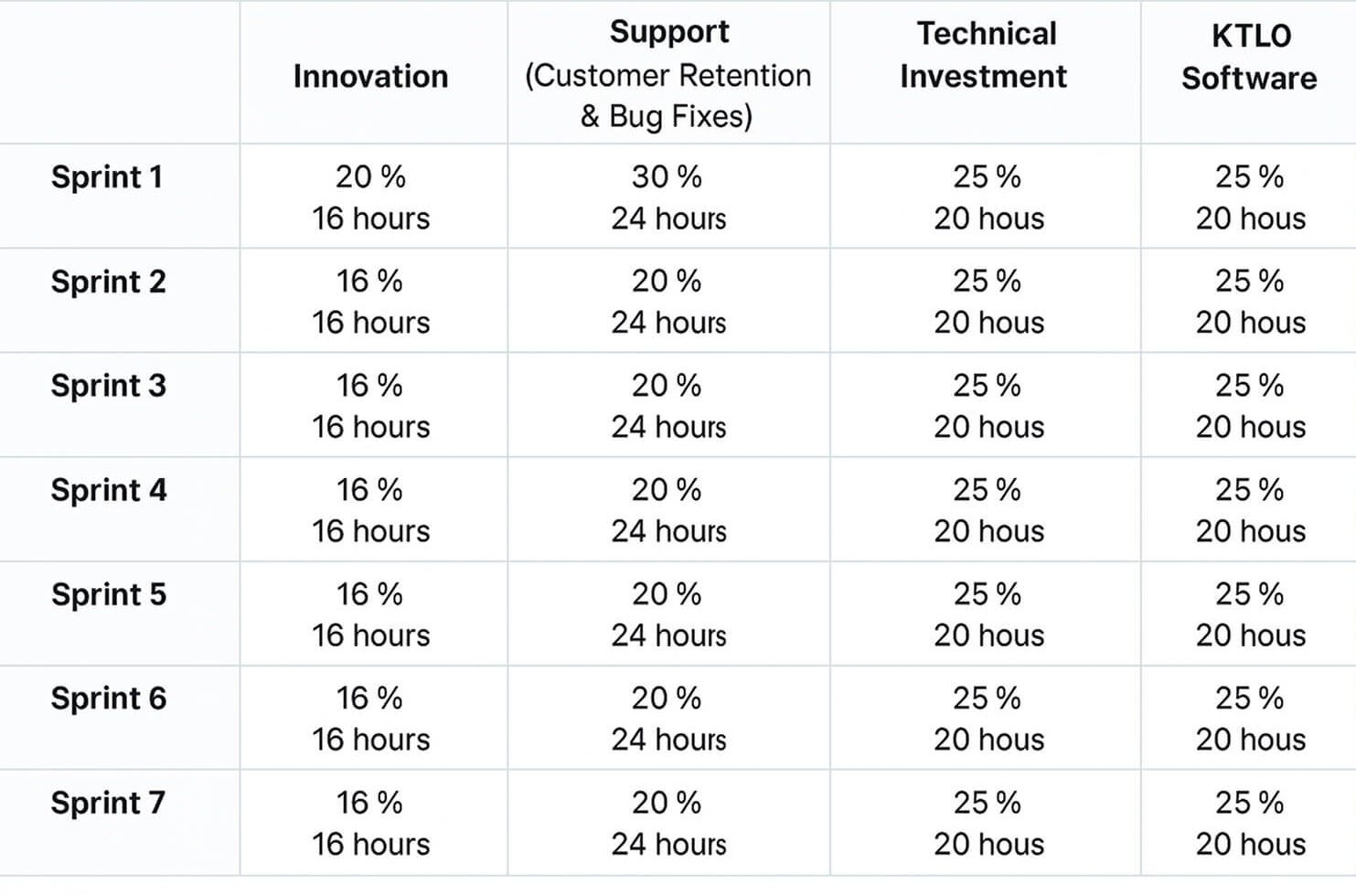
The spreadsheet becomes your team’s single source of truth for planned versus actual time distribution.
3. Agree On Baseline Percentage Targets
Make baseline percentage allocations that align with business goals by working with managerial and engineering leadership.
- Innovation allocation: Typically 35–50% for growth-focused teams, less for mature products.
- Support allocation: Usually 20–35% depending on product stability and customer base size.
- Technical investment: Generally 15–25% to maintain healthy technical debt levels.
- KTLO allocation: Aim for 5–15% with a focus on reducing over time through automation.
Example baseline: 40% Innovation, 30% Support, 20% Technical Investment, 10% KTLO.
4. Convert Percentages to Hours
Transform your percentage targets into concrete hour allocations for each sprint.
- Calculate hours per category: Baseline percentage × total sprint hours.
- Include formulas in a spreadsheet: Automatic calculation prevents manual errors.
- Validate totals: Ensure all categories sum to 100% of available capacity.
With 450 total hours, Innovation gets 180h, Support gets 135h, Technical gets 90h, and KTLO gets 45h.
5. Structure Rows by Sprint
Organize your template with clear sprint identification and consistent hour distribution.
- Sprint labeling: Use a consistent naming convention (Sprint 1, Sprint 2, or date ranges).
- Hour distribution: Populate each sprint row with calculated hours from percentage targets.
- Future planning: Include 6–8 sprints ahead for medium-term capacity planning.
This structure enables both planning and historical analysis of allocation effectiveness.
6. Add a Notes Column
Include space for capturing insights and adjustments that inform future allocation decisions.
- Variance explanations: Document why the actual allocation differed from the planned.
- Sprint retrospective insights: Key learnings that should influence future planning.
- External factors: Customer escalations, urgent requests, or organizational changes that impacted allocation.
Example note: “Innovation overrun by 5h due to underestimated API complexity—increase technical spike time for Sprint 3.”
7. Review & Iterate
Validate your template through team collaboration before implementing it as your standard planning tool.
- Team walkthrough: Present the template and explain the allocation logic to all engineers.
- Pilot testing: Run 2–3 sprints with the template before finalizing the approach.
- Documentation – This offers straightforward guidance on how teams will implement and sustain the template.
Tracking and Adjusting Allocations Over Time
Efficient allocation management necessitates ongoing monitoring and adjustments based on actual delivery patterns.
- Evaluating planned versus actual hours is accomplished through time-tracking systems or story point analysis. Apply color-coded displays for every allocation category to identify if it exceeds or falls short of its established capacity limits.
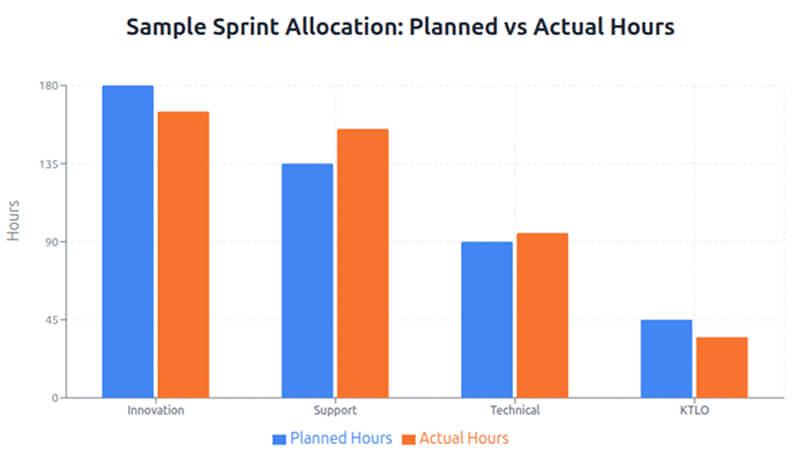
- Rotating ownership tracking distributes responsibility across team members through weekly rotation schedules, clear tracking responsibilities, knowledge sharing during retrospectives, and skill development opportunities. This prevents tracking from becoming a single person’s burden while building a team-wide understanding of allocation dynamics.
Measuring Success and ROI
Quantifying the impact of your allocation model requires tracking metrics that connect engineering activities to business outcomes. These measurements demonstrate the value of structured time management and guide future decisions.
- Innovation velocity: measures feature delivery capability through features delivered per quarter, story points completed in innovation work, and time-to-market improvements. If your team delivered 12 features in Q1 and 15 in Q2 after implementing allocation, that’s a 25% velocity improvement.
- Support effectiveness: Tracks bug count reduction, average resolution time, customer satisfaction scores, and repeat issue frequency. Effective support allocation results in decreasing bug backlogs and faster resolution times, which directly impact customer retention.
- KTLO burden analysis: Compares actual versus target KTLO hours, measures automation impact, tracks incident frequency, and calculates capacity liberation. Lower KTLO burden indicates successful automation and system maturity, freeing capacity for innovation.
Example: A 25% faster feature delivery might capture market opportunities 3 months earlier, generating revenue that far exceeds the costs of allocation discipline.
Wrapping Up
Engineering time is a critical, non-renewable resource requiring disciplined management. It requires a systematic approach to investment allocation across four categories, including innovation, customer support, technical investment, and KTLO maintenance.
Clearly defined objectives, trustworthy delivery, and proactive management of technical debt are key benefits of disciplined investment management.
Begin with a basic strategy, track results, and then adjust based on actual trends. This will transform your engineering chaos into a strategic advantage, because every hour spent without intention is an opportunity lost forever.




